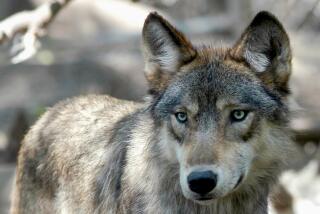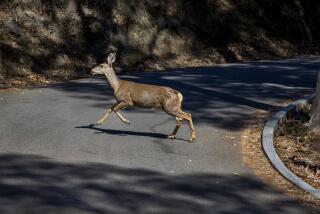The Lewis & Clark Trail Revisited
- Share via
SEATTLE — When Lewis and Clark led their Corps of Discovery west nearly 200 years ago they were familiar with the wolves they encountered. Just like the ones back in Virginia.
But the coyote was a new critter. They killed one in 1804 in what is now South Dakota and described it as smaller wolf, “the burrowing wolf of the prairie,” with piercing green eyes.
Today, the wolf survives in only the most remote parts of the United States. Meanwhile, its coyote cousin has crept across the country from the West, Benjamin Long writes in “Backtracking by Foot, Canoe and Subaru Along the Lewis and Clark Trail” (Sasquatch Books, Seattle).
“Wise, nocturnal coyotes ghost through the suburbs of Washington, D.C. They raid watermelon patches in rural Florida,” he writes.
Why has the coyote flourished and the wolf declined since the days of Lewis and Clark? The clever, quiet coyote can live among people. The cattle-eating wolf cannot. Wolves also kill coyotes. With wolves gone, coyotes thrive.
“Backtracking” neatly links the changing wildlife-people relationship from the time of Lewis and Clark to the modern-day camping adventures of Long and his wife, photographer Karen Nichols.
The Kalispell, Mont., couple loaded up their Subaru and went hiking and canoeing along the Lewis and Clark trail in Montana, Idaho and Washington.
“The canoe once transported people across distance. In a world of supersonic jets and space shuttles, the canoe now transports across time,” he writes.
Long and Nichols looked for some of the 172 animals Lewis and Clark described for President Jefferson and science. Long tells how the wolf, coyote, bison, grizzly, beaver, grouse, cutthroat trout and others fare today.
For most of the wildlife, being discovered by Lewis and Clark was the beginning of the end. Beaver at the Three Forks headwaters of the Missouri River couldn’t be found 30 years later. Tens of millions of buffalo were reduced to 300 by 1883.
Long tells these stories with appreciation for the land, animals and people, without the sentimentality of extreme nature lovers or the “more sensitive than thou” subtext of some writers. He’s a fisherman who doesn’t release everything he catches because pan-fried is a good way to know a trout too.
His writing talent smoothly braids American history, natural history and his own travel adventures into a strong book. Long understands the power of the short sentence and the vivid image.
Describing a barbed-wire fence along a Montana highway he writes: “The posts were not driven into the hard pan, and the fence was held in place by its own tension, like a bad marriage.”
Growing up along the Lewis and Clark trail in the Idaho Palouse, Long writes that the discoveries of the explorers fired his boyhood imagination. “Backtracking” lights that fire in its readers.
The country will be hearing much more about Lewis and Clark in the next couple of years. This is a great start on the bicentennial.
More to Read
Sign up for The Wild
We’ll help you find the best places to hike, bike and run, as well as the perfect silent spots for meditation and yoga.
You may occasionally receive promotional content from the Los Angeles Times.






